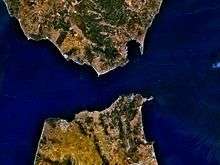1 myriametre
A clickable mosaic of objects
at scales within direct human experience, from the micrometric (10−6 m, top left) to the multi-kilometric (105 m, bottom right).
at scales within direct human experience, from the micrometric (10−6 m, top left) to the multi-kilometric (105 m, bottom right).

The Strait of Gibraltar is 13 kilometres wide
To help compare different orders of magnitude this page lists lengths between 10 and 100 kilometres (104 to 105 metres). The myriametre (sometimes also spelled myriameter, myriometre and myriometer) (10,000 metres) is a deprecated unit name; the decimal metric prefix myria- (sometimes also written as myrio-) is obsolete and not included among the prefixes when the International System of Units was introduced in 1960.
Conversions
10 kilometres is equal to:
- 10,000 metres
- 6.2 miles
- 1 mil (the Scandinavian mile), now standardized as 10 km:
- 1 mil, the unit of measure commonly used in Norway and Sweden[1] used to be 11,295 m in Norway and 10,688 m in Sweden.
- 1 peninkulma, unit of measure commonly used in Finland; earlier peninkulma was 10.688 km.
- 1 farsang, unit of measure commonly used in Iran and Turkey.
Sports
Human-defined scales and structures
- 18 km – cruising altitude of Concorde
- 27 km – circumference of the Large Hadron Collider, as of May 2010 the largest and highest energy particle accelerator
- 30 km – length of the longest man made dike enclosed by water on two sides, the Afsluitdijk
- 31.3 km – highest parachute jump (Joseph Kittinger)
- 34.668 km – highest manned balloon flight (Malcolm D. Ross and Victor E. Prather on May 4, 1961) [3]
- 38.422 km – length of the Second Lake Pontchartrain Causeway in Louisiana, US
- 39 km – undersea portion of the Channel tunnel
- 53.9 km – length of the Seikan Tunnel, as of October 2009, the longest rail tunnel in the world[4]
- 77.1 km – total length of the Panama Canal
Geographical
- 10 km – height of Mauna Kea in Hawaii, measured from its base on the ocean floor
- 11 km – deepest known point of the ocean, Challenger Deep in the Mariana Trench
- 11 km – average height of the troposphere
- 21 km – length of Manhattan
- 23 km – depth of the largest earthquake ever recorded in the United Kingdom, in 1931 at the Dogger Bank of the North Sea
- 34 km – narrowest width of the English Channel at the Strait of Dover
- 50 km – approximate height of the stratosphere
Astronomical
- 10 km – diameter of the most massive neutron stars (3–5 solar masses)
- 13 km – mean diameter of Deimos, the smaller moon of Mars
- 20 km – diameter of the least massive neutron stars (1.44 solar masses)
- 20 km – diameter of Leda, one of Jupiter's moons
- 20 km – diameter of Pan, one of Saturn's moons
- 22 km – diameter of Phobos, the larger moon of Mars
- 27 km – height of Olympus Mons above the Mars reference level,[5][6] the highest known mountain of the Solar System
- 43 km – diameter difference of Earth's equatorial bulge
- 66 km – diameter of Naiad, the innermost of Neptune's moons
Notes
- ↑ km is an abbreviation of kilometre
References
- ↑ Haugen, Einar, Norwegian English Dictionary, 1965, Oslo: Universitetsforlaget and Madison: University of Wisconsin Press, s.v. mil
- ↑ "IAAF Competition Rules 2008" (pdf). IAAF. p. 195. Archived from the original on 2009-04-25. Retrieved 2009-04-20.
- ↑ Gregory Kennedy. "Stratolab, an Evolutionary Stratospheric Balloon Project".
- ↑ Wise, Jeff (October 1, 2009). "Turkey Building the World's Deepest Immersed Tube Tunnel". Popular Mechanics. Retrieved January 2011.
- ↑ Highest and lowest points on Mars NASA
- ↑ Plescia, Jeff (1997-10-01). "Height of Martian vs. Earth mountains". Questions and Answers about Mars terrain and geology. Retrieved 2009-04-20.
| ||||||||||
This article is issued from Wikipedia - version of the Friday, December 18, 2015. The text is available under the Creative Commons Attribution/Share Alike but additional terms may apply for the media files.